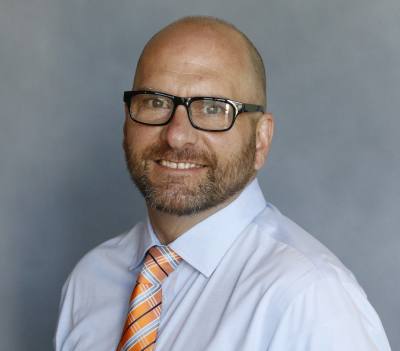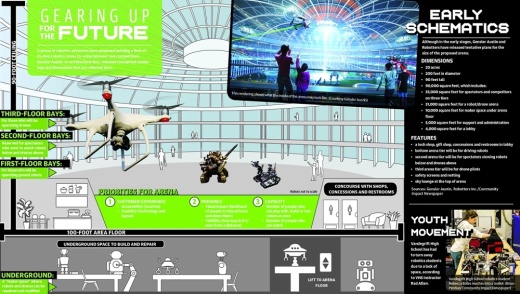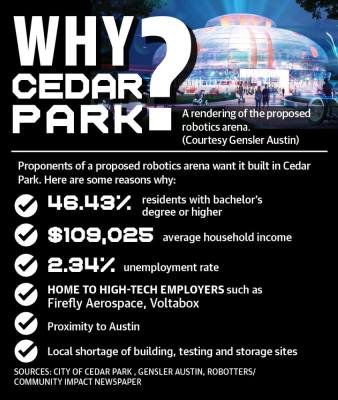Five years from now, similar teams may be able to take a robot they designed and built for a test drive—or flight—in a first-of-its-kind robotics space.
Gensler Austin, an international architectural and design firm, and Elijah May, the co-founder and CEO of robotics advocacy nonprofit Robotters, released early design plans Feb. 13 to build a “Topgolf-style” robotics arena in Cedar Park.
“While still in the early planning stages, the Cedar Park-based arena will be the first of its kind in the nation,” Gensler spokesperson Anuradha Koli said.
Local proponents say a robotics space, particularly for children, has been needed for nearly a decade.
Gensler Austin project architect Thomas Boes said the initial footprint would be approximately 20 acres with the capability to expand up to 30-50 acres for ancillary businesses and workshops, he said.The plans call for a 90,000-square-foot, for-profit facility that would include a concessions area; three tiers of spectator/competitor areas, or bays; and subterranean “maker spaces” with tools and parts where robots could be repaired and modified.Individuals would be able to rent one of the bays, for either viewing or competing, on the three tiers and have access to concessions and drinks.“Think Topgolf meets quidditch,” said Boes, referencing a golfing and entertainment franchise and a game created in the “Harry Potter” book series.Both amateurs and individuals with robotics knowledge would be able to rent the bays. Individuals would also be able to bring their own robots, according to May.
“If you’re serious about bowling, you bring your own bowling ball. If you’re serious about pool, you bring your own cue,” May said.
While the plans have generated a lot of interest, neither funding nor a parcel has been secured for the proposed arena, according to May and Boes, who also declined to provide an estimated cost.
It is also unknown specifically what type of zoning would be required for the facility, according to Cedar Park spokesperson Jennie Huerta.
“Because we have not received any applications or information regarding this project, which would be necessary to determine appropriate zoning, we cannot speculate the type of zoning that might be required,” Huerta said in a March 3 email.
May confirmed that his group has not formally communicated with the city. However, he said he plans to officially reach out to Cedar Park officials within the next few weeks.
“We intend to engage the city in a conversation about parcels of land that might meet our needs,” he said.
Community Impact Newspaper inquired with the Austin Board of Realtors requesting the number of Cedar Park parcels that are 20 acres or larger and the price range of those parcels, but a spokesperson said ABoR “do[es] not have access to that data at this time.”
Gensler Austin, which created and distributed the early design plan, is no stranger to large projects. The firm also created the master plan for Indigo Ridge, a planned $1.5 billion development in Cedar Park. It is also helping design the Austin FC Stadium in Northwest Austin and the Moody Center on The University of Texas-Austin campus, according to its website.
May and Boes admit the plans are ambitious, but they say the proposal is ahead of its time and aims to meet the current and future growth in local robotics, especially at the youth level.
On Feb. 17-18, H-E-B Center at Cedar Park hosted the International Robotters Festival, which drew youth teams from 10 countries and received $45,000 in funding from the city’s hotel occupancy tax revenue. Leading up to the event, May said he was in communication with Tourism Director Saridon Stanton. He has spoken with at least two politicians about the proposed arena.
“I’ve talked with [Council Member] Mel Kirkland and [council candidate] Eric Boyce because I’ve known them for years, and we’ve all been part of both formal and informal conversations about the future of Cedar Park and its place in the region and the state, and even the world,” Mays said.
Kirkland atttended the International Robotters Festival."I think this [arena] is a brilliant opporunity for Cedar Park and it wouldn't really compete with the H-E-B Center," he said.
As Cedar Park has grown, so has robotics in Leander ISD, according to trustee Gloria Gonzales-Dholakia, a longtime robotics advocate.“I’ve been involved for 12 years,” said Gonzales-Dholakia, who has three sons who grew up interested in robotics. “Back then, there were small pockets, but a lot of it was parent-led and community-led. Vandegrift [High School] was a school that started a small program about 10 years ago. It was really small, about four students. Now it’s 104 students. It’s grown at all of our campuses.”
Vandegrift’s lead robotics adviser Rad Allen said the program has become so popular that he has to turn students away who are interested in his program.
“We have more students that want to be involved than what we can safely manage,” Allen said.
Allen said that will change in August, when VHS opens its new 7,700-square-foot robotics facility—more than tripling the current 2,400-square-foot space.
Nearly 10 miles north of VHS in Cedar Park, Boes hopes a parcel for the arena can be secured by the end of the year.Boes pointed to the quick turnaround of the plan to build the $338 million Moody Center on The University of Texas at Austin campus—when ground was broken in December, one year after the project was announced.He said the robotics arena project may not be as distant as it seems.
“As was shown with the Moody Center, you can execute a plan like this very quickly,” he said.






